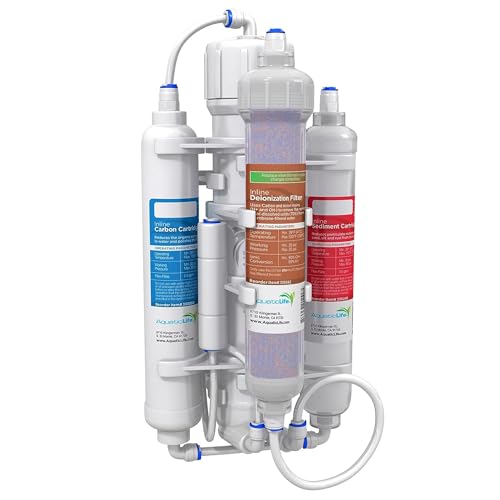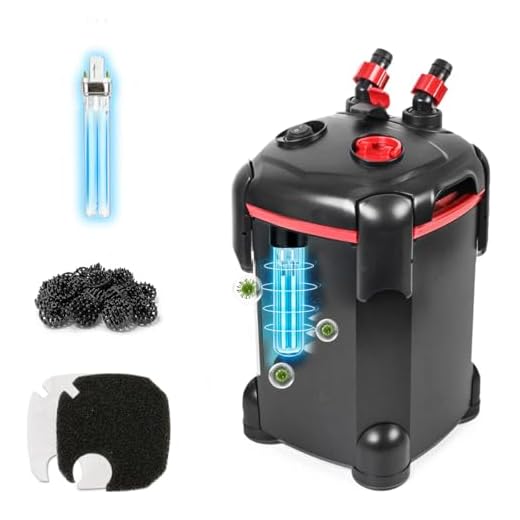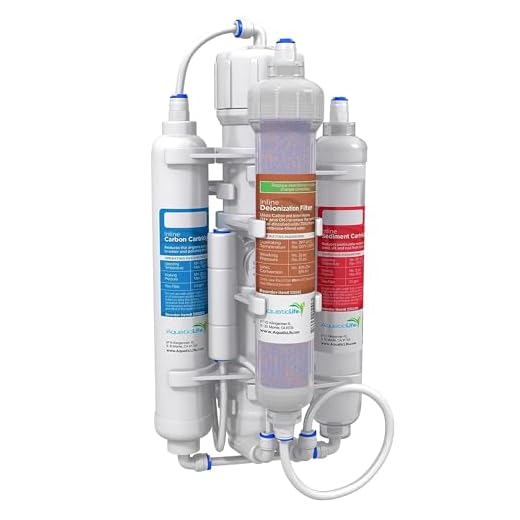Reef
Blog
Is purified water good for fish tanks

Purified water is a popular choice for many fish owners when it comes to maintaining a fish tank. The appeal of purified water is the belief that it is free from impurities and chemicals that may harm fish. However, there is ongoing debate within the fishkeeping community about whether purified water is actually beneficial for fish tanks.
Advocates of purified water argue that it provides a clean and safe environment for fish. They claim that removing impurities such as chlorine and heavy metals from tap water can improve fish health and reduce the risk of diseases. Purified water is also believed to prevent algae growth and maintain water clarity, making the tank more visually appealing.
On the other hand, some experts express concerns about purified water. They argue that removing all impurities can also strip the water of essential minerals that fish need for their well-being. Without these minerals, fish may become stressed and susceptible to diseases. Additionally, purified water may lack the necessary beneficial bacteria that help to establish a healthy aquarium ecosystem.
In conclusion, while purified water may have its advantages in terms of providing a clean and clear environment, its potential drawbacks should be considered. Before using purified water in a fish tank, it is recommended to thoroughly research and consult with experts to ensure the optimal conditions for the well-being of the fish.
Benefits of Purified Water for Fish Tanks
Using purified water in fish tanks can provide several benefits for the well-being and health of the fish. Here are some of the advantages:
- Removal of Contaminants: Purified water goes through a filtration process that removes harmful contaminants such as chlorine, chloramine, heavy metals, and other impurities. These contaminants can have a negative impact on the fish, causing stress, illness, and even death. By using purified water, you ensure a safer and cleaner environment for your fish.
- Optimal pH Levels: Purified water typically has a neutral pH, which is crucial for maintaining the proper pH levels in the fish tank. Fluctuations in pH can stress fish and lead to health issues. By using purified water, you can maintain a stable and suitable pH level, promoting a healthy habitat for your fish.
- Reduces Algae Growth: Algae growth is a common issue in fish tanks, which can lead to poor water quality, oxygen depletion, and an unsightly appearance. Purified water reduces the presence of nutrients that fuel algae growth, helping to keep your tank clean and algae-free.
- Prevents Disease Transmission: Using purified water can help reduce the risk of introducing diseases or parasites to your fish tank. Tap water may contain pathogens or microorganisms that are harmful to fish. Purified water minimizes this risk, providing a healthier environment for your fish.
- Enhances Fish Colors: Purified water often lacks the chemicals and impurities that can dull the colors of fish. By using purified water, you can enhance the vibrancy and brilliance of your fish’s natural colors.
Overall, the use of purified water in fish tanks can contribute to the overall well-being and longevity of your fish population. It helps create a clean and stable environment, reducing the risk of stress, disease, and poor water quality. Consider using purified water in your fish tank to provide the best possible conditions for your aquatic pets.
Enhances Fish Health
Purified water can greatly enhance the overall health of fish in a tank. When fish are exposed to impurities in tap water, it can lead to various health issues that can compromise their well-being and lifespan. Purifying the water before adding it to the tank helps to create a clean and healthy environment for the fish to thrive.
Here are some ways in which purified water enhances fish health:
Removes Harmful Contaminants
Tap water often contains contaminants such as chlorine, chloramines, heavy metals, and pesticides. These substances can have a negative impact on fish health, causing stress, damage to the gills, and suppressed immune systems. Purified water goes through a filtration process that removes these harmful contaminants, providing a safer and healthier habitat for the fish.
Optimizes Water Parameters
Purified water allows for precise control of water parameters such as pH, hardness, and mineral content. This is especially important for sensitive fish species that require specific water conditions to thrive. By eliminating impurities and providing a clean slate, purified water enables fish owners to create the ideal environment for their fish, mimicking their natural habitats.
Purified water also reduces the risk of sudden water parameter fluctuations, which can be stressful for fish and lead to health issues. Consistent and stable water conditions promote overall fish well-being and reduce the likelihood of diseases.
Prevents Diseases
Using purified water in fish tanks can help prevent the introduction of disease-causing organisms. Tap water may contain bacteria, parasites, and viruses that can be harmful to fish. Filtering the water removes these potential culprits, reducing the risk of fish becoming sick. It is important to note that while purified water can help prevent diseases, maintaining good tank hygiene, proper nutrition, and regular water testing are also crucial for maintaining fish health.
Overall, using purified water in fish tanks can have a significant positive impact on fish health. It provides a clean and safe environment, optimizes water parameters, and reduces the risk of diseases. Fish owners should consider purifying their water source to ensure the well-being and longevity of their aquatic pets.
Reduces Algae Growth
Purified water can help to reduce algae growth in fish tanks. Algae thrive in the presence of nutrients such as nitrates and phosphates, which are commonly found in tap water. However, purified water goes through a filtration process that removes these nutrients, making it less likely for algae to grow.
Without the presence of excess nutrients, the growth of algae can be significantly reduced. This can make the aquarium look cleaner and more visually appealing, as well as create a healthier environment for the fish.
It is important to note that while purified water can help to reduce algae growth, it is not a complete solution. Other factors such as lighting levels, temperature, and the presence of live plants also contribute to algae growth in fish tanks. Therefore, it is important to maintain a balance of these factors in order to effectively control algae growth.
In conclusion, using purified water in fish tanks can be beneficial in reducing algae growth. However, it should be used in conjunction with other appropriate aquarium care practices to ensure a healthy and thriving fish tank environment.
Improves Water Clarity
Purified water can greatly improve the clarity of the water in fish tanks. With its impurities removed, purified water is free from substances that can cause cloudiness or discoloration in the tank. This means that the water will remain clear and transparent, allowing for better visibility of your fish and the overall aesthetics of the tank.
When the water is clear, it is easier to spot any issues or problems that may arise in the tank. This includes spotting any signs of illness or distress in the fish, as well as being able to identify any potential water quality issues. Improved water clarity also enhances the overall viewing experience of the tank, making it more enjoyable for both the fish and the viewers.
Minimizes Waste Build-up
Purified water in fish tanks can help minimize waste build-up, ensuring a healthier and cleaner environment for the fish. When fish produce waste, it releases ammonia, nitrites, and nitrates into the water. Over time, these waste products can accumulate and become toxic to the fish. By using purified water, you can reduce the levels of these harmful substances, promoting better water quality.
Additionally, purified water contains fewer impurities and chemicals that can contribute to waste build-up. Tap water, for example, often contains chlorine, chloramines, and heavy metals that can be harmful to fish and promote the growth of algae. Purified water, on the other hand, has undergone filtration processes to remove these impurities, reducing the likelihood of waste accumulation and algae growth.
Furthermore, purified water can help prevent the accumulation of excess nutrients in the tank, such as phosphates and silicates. These nutrients can contribute to the growth of unwanted algae, affecting the aesthetics of the tank and potentially harming the fish. By using purified water, you can minimize the introduction of these nutrients, resulting in a cleaner and healthier tank environment.
Conclusion
Overall, using purified water in fish tanks can help minimize waste build-up, promote better water quality, and create a healthier environment for the fish. By reducing the levels of harmful substances and impurities, purified water ensures that the fish can thrive without the risk of toxicity or excessive nutrient accumulation. Consider using purified water for your fish tank to maintain optimal conditions for your aquatic pets.
Prevents Disease Outbreaks
Purified water is an essential component in preventing disease outbreaks in fish tanks. When fish are kept in an environment with poor water quality, they become more susceptible to various diseases and illnesses. Unclean water with high levels of contaminants can weaken the immune system of fish, making them vulnerable to bacterial, fungal, and parasitic infections.
Using purified water helps maintain optimal water parameters, such as pH, temperature, and dissolved oxygen levels. This creates a healthier and more stable aquatic environment, reducing the stress on fish and minimizing their susceptibility to diseases. The removal of harmful substances and impurities through the purification process eliminates potential sources of pathogens that could cause disease outbreaks.
In addition, purified water does not contain chlorine or chloramines, which are commonly used to treat tap water. These chemicals can be harmful to fish and may cause irritation to their gills and skin. By using purified water, fish owners can ensure that their aquatic pets are not exposed to potentially harmful substances present in tap water.
Benefits of Using Purified Water in Fish Tanks
Some of the benefits of using purified water in fish tanks include:
- Improved fish health and well-being
- Reduced risk of disease outbreaks
- Enhanced growth and vitality of fish
- Reduced stress on fish
- Improved water clarity
Choosing the Right Type of Purified Water
When selecting purified water for fish tanks, it is important to choose the right type depending on the specific needs of the fish species. Different fish species have different water parameter requirements, such as pH and hardness levels. Therefore, it is necessary to consider these factors and choose purified water that closely matches the natural habitat of the fish.
Some options for purified water suitable for fish tanks include reverse osmosis (RO) water, distilled water, and deionized (DI) water. It is generally recommended to use a combination of these purified water types to achieve the desired water parameters for a particular fish species.
| Purified Water Type | Advantages | Disadvantages |
|---|---|---|
| Reverse Osmosis (RO) Water | – Removes most impurities – Highly customizable |
– May remove beneficial minerals – Requires additional equipment |
| Distilled Water | – Completely pure – Removes all impurities |
– Lacks minerals – Requires regular purchase or production |
| Deionized (DI) Water | – Removes all impurities – Highly pure and customizable |
– Requires specialized equipment – Expensive |
Question & Answer
Is purified water safe to use in a fish tank?
Purified water can be safe to use in a fish tank, as long as it is properly prepared. It is important to remove any chlorine or other harmful chemicals from the water before adding it to the tank.
What are the benefits of using purified water in a fish tank?
Using purified water in a fish tank can help maintain optimal water quality for the fish. Purified water is free from impurities and contaminants that can be harmful to fish. It can also help prevent the buildup of algae and other unwanted substances in the tank.
Can using purified water in a fish tank be harmful?
While purified water can be beneficial for fish tanks, it can also be harmful if not used properly. If the water is not properly conditioned or if it lacks essential minerals, it can disrupt the pH balance and create an inhospitable environment for fish. It is important to properly prepare purified water before adding it to the tank.
What types of purified water are safe for fish tanks?
There are several types of purified water that can be safe for fish tanks. These include distilled water, reverse osmosis water, and deionized water. However, it is important to note that some types of purified water may lack essential minerals that are beneficial for fish, so it may be necessary to supplement the water with appropriate additives.
Is it necessary to use purified water in a fish tank?
Using purified water is not always necessary in a fish tank. Tap water can be safe for fish if properly conditioned and treated to remove chlorine and other harmful substances. However, if the tap water in your area contains high levels of impurities or contaminants, using purified water may be a better option to ensure the health and well-being of your fish.
Is purified water safe for fish tanks?
Purified water can be safe for fish tanks if certain conditions are met. However, it is important to note that not all purified water is suitable for fish tanks, as some purification processes may remove essential minerals and elements that are necessary for fish health.





